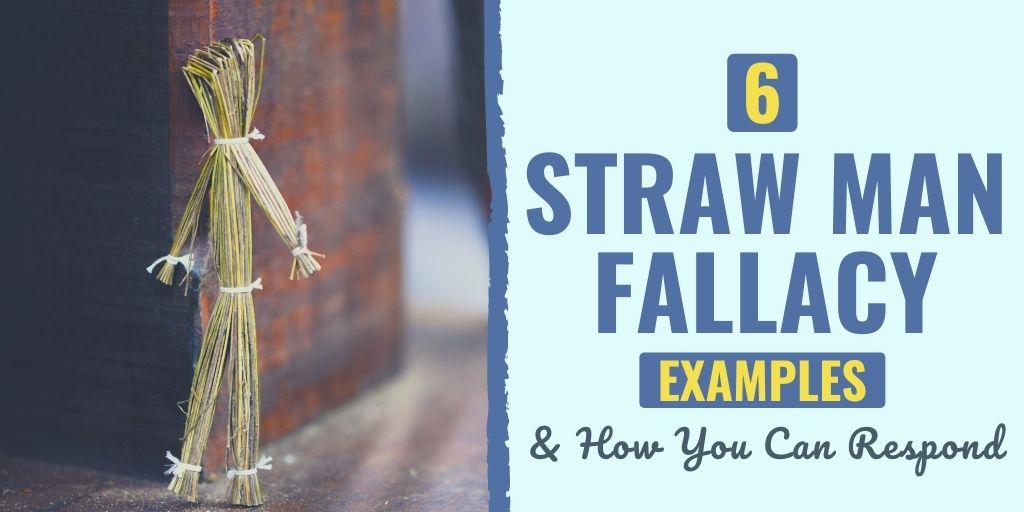There might be affiliate links on this page, which means we get a small commission of anything you buy. As an Amazon Associate we earn from qualifying purchases. Please do your own research before making any online purchase.
In the context of a debate, it’s always good practice to make sure you clearly understand your opponent’s position before you respond, so you can argue against their actual views. Unfortunately, good practice doesn’t always come through and people end up misrepresenting other people’s views.
A straw man fallacy is a kind of logical fallacy that occurs when a person deliberately distorts their opponent’s argument and proceeds to argue against that distortion instead of the actual position.
Straw man arguments are so named because the person erects a “straw man” of their opponent’s position and proceeds to attack it instead of the person’s actual views.
Straw man fallacies rear their ugly head all over the place. They are a particularly nasty logical fallacy as they are often used in debates about controversial or hot-button topics to make the opposition position seem absurd or otherwise indefensible. That’s why we are going to cover some examples of this dangerous fallacy and talk about how to respond to these kinds of arguments.
Understanding Straw Man Fallacies
Here is a simple example of a straw man fallacy in a conversation between two people:
A: “We should divert more federal funding to social programs as those help people manage their expenses and contribute to the economy.”
B: “That is completely ridiculous! We can’t just give money to people who don’t work, that would make them lazy and greedy.”
B’s response is a straw man fallacy. It’s a straw man fallacy because A didn’t say that we should give free money to people who don’t work. They merely stated that more federal funds should be diverted to social programs, many of which go to people who do, in fact, work. B begins by giving a straw man of A’s position and then proceeds to argue against that position as if it’s what A believes.
Instead of arguing against the actual position, B argues against a caricature of A’s argument. Straw man fallacies occur when a person misrepresents their opponent’s position or argument and argues against that caricature instead of the actual position. Straw man arguments give the illusion of refuting an argument by attacking a figment of reasoning rather than the actual reasoning.
In our example, it doesn’t really matter if what B claims is true (that giving people who don’t work money will make them lazy) because that claim is a misrepresentation of A’s position and is irrelevant to the overall discussion (A didn’t say anything about giving money to people who don’t work).
Logical Form of Straw Man Fallacies
Straw man fallacies are informal fallacies so they’re not so much a matter of logic per se but of rhetoric. That being said, straw man fallacies share this general form:
As you can see, straw man fallacies are a kind of bait-and-switch rhetorical trick. The person guilty of straw-manning presents a position Y that sounds somewhat similar to X but is substantially different in key aspects. They then refute position Y and claim that they have thus refuted X. Tricky indeed!
Straw man arguments can take a lot of forms. Common straw-manning methods include:
There are lots of ways to straw man but these methods share one thing: They all rely on distorting a position to make it easier to argue against. A common straw-manning tactic is to present an absurd caricature of your opponent’s position and argue against the obviously weaker absurd position.
6 Straw Man Fallacy Examples
1. Evolution
Straw man arguments about the topic like evolution are extremely common. The theory of evolution can be difficult to understand and is prone to being misrepresented.
Argument: “The theory of evolutionholds that humans came from chimpanzees. But if that were true, then why are chimpanzees still around? Shouldn’t they have evolved into humans by now? That makes me think the theory of evolution is false.”
Counterargument: This is a straw man fallacy because it inaccurately portrays the claims of evolutionary theory and argues against that inaccurate view. The theory of evolution by natural selection does not claim that human beings evolved from chimpanzees. Rather, humans share our closest common ancestors with chimps (and bonobos for that matter!).
This means humans didn’t evolve from chimpanzees, but that both humans and chimps descended from a common ancestor that was neither human nor chimp. The ancestral relationship between chimps and humans isn’t a straight line, but more like a “V” where both humans and chimps stem from a common ancestor. So the fact that chimps currently exist is irrelevant to the claim that humans are evolutionarily related to chimps.
2. Atheism
You could probably fill a book with all the straw man arguments against atheists. Here is a common one you might’ve heard.
Argument: “Atheists claim to believe that God does not exist, but they also hate God. But how can you hate something that does not exist? The fact that atheists hate God means that they are liars and actually believe God exists.”
Counterargument: This is a clear case of a straw man. First, nothing about atheism necessitates hatred of God. Atheism at its core is just the belief that God doesn’t exist.
Secondly, while it’s true that many atheists don’t have a favorable opinion of God’s described actions and attributes, that doesn’t mean that they actually think God exists. Rather, they think that the concept of God carries negative qualities such that if God existed, then he would not be an example of moral behavior and qualities. You can disapprove of a particular concept even if there is nothing in the world that instantiates that concept.
3. Religion
There are also straw man arguments against religious positions.
Argument: Religion denies scientific evidence. So, if you are religious, then you necessarily deny the legitimacy of the scientific project. If you are religious, you don’t believe in science.”
Counterargument: This one is a straw man for a couple of reasons. First off, it paints “religion” as if it were a singular unitary concept that is the same everywhere. There are tons of religions all over the world that may have radically different views from one another. Buddhism and Christianity, for example, share relatively little in common in terms of beliefs.
Secondly, being religious does not mean you must, therefore, reject science. There are conceptions of religion that are compatible with science. This particular argument is also an example of a false dilemma fallacy as it assumes the only two mutually exclusive possible options are believing in religion or believing in science.
4. Politics
It wouldn’t be a logical fallacy if it wasn’t all over the place in politics, right? Strawmanning is very common in politics as it’s an easy way to attribute sinister or absurd views or motives to opponents.
Argument: “Liberals criticize America, which means they must hate America. Why are we voting for people that hate and want to destroy America? Liberals need to stop hating America if anyone is going to vote for them.”
Counterargument: It’s pretty easy to see why this argument is a straw man. Criticizing something doesn’t mean that you hate something. One could argue that liberals criticize aspects of America because they love America and realize that our country can be a better place. The distortion comes in when mere criticism of something is interpreted as expressing hatred.
Further, progress is impossible if we cannot criticize the existing system. If bad parts of America can never be criticized, then how are we supposed to make those things better? There is also the fact that a lot of conservatives criticize America too. Obviously, just because conservatives criticize parts of America doesn’t mean they hate America either. The same is true for liberals.

5. Feminism
Feminist positions on issues are often distorted to make feminists seem ridiculous or hateful.
Argument: “Feminists hate men and want to destroy the nuclear family. Also, feminists deny that there are any differences whatsoever between men and women so they are unscientific too.”
Counterargument: First off, it’s not true that feminists hate men. Rather feminists are keenly aware of how gendered assumptions and biases cause inequalities in society. It’s perfectly legitimate for feminists to criticize systems of ideas that lead to inequality. Many feminists also point out how these kinds of assumptions and biases also hurt men, which they probably wouldn’t care to do if they really hated men.
Feminists also don’t deny that there are any differences between men and women. Feminists just think that these differences should not be used to force people to behave or act in certain ways. It might be true that women typically are mothers, but that does not mean that each individual woman should be expected to become a mother. There’s a difference between saying something is the case and that something should be the case.
6. Healthcare
Here’s a conversation with a straw man regarding healthcare.
Argument:
- A: “The government needs to step in and do something about these out of control medical prices. How can someone afford $500 insulin on a monthly basis?”
- B: “Are you serious? We can’t just give people free healthcare, that would never work and it would cost way too much money!”
Counterargument: B’s response to A is a straw man. It’s a strawman because A did not say anything about giving people medical care for free. They just said that the government needs to control prices on drugs. B presents A’s position as the claim that the government should give free healthcare, but A made no such claim. B distorts A position in order to make it easier to argue against.
Notice that B never actually refutes A’s position. They only refute a caricature of A’s argument. Even if it were true that free healthcare would cost too much money, that is irrelevant to what A said. Again, straw man arguments present the illusion of a refutation.
Responding to Straw Man Fallacies
Countering a straw man fallacy is pretty straightforward. First, try to present your position as clearly and definitively as you can. The less ambiguous your argument is, the less vulnerable it is to being strawmanned.
If your argument does get strawmanned, here are some ways to respond:
In general, the best way to respond to a straw man is to point out how it’s a distortion. Straw man fallacies result from distorting a position so it’s best to show why the straw man argument and the actual position are not the same.

Straw Man vs Steel Man
In contrast to the straw man, there is what is called a steel man. Steel manning is when you provide the strongest possible version of your opponent’s view and then proceed to argue against it. Unlike the straw man, which creates a distorted caricature of your opponent’s argument, a steel man presents it in the best possible light.
Steel manning is an integral part of proper debate etiquette. Before you are entitled to criticize anyone’s view, you must present the strongest possible version of that person’s view then criticize it. To do otherwise runs afoul the principle of charity, the idea that you should seek to understand an opponent’s view in its strongest form and interpret their words in the most reasonable way possible.
Here is a general rule of thumb for steel manning. Before you criticize a person’s position, try to reiterate their argument to them in such a way that makes them think “Dang, I wish I thought to put my views that way!” Only then are you entitled to make a critique of the opposing view.
Learn More About Logical Fallacies
- 5 Appeal to Nature Fallacy Examples in Media and Life
- 6 Outcome Bias Examples That Can Negatively Impact Your Decisions
- 7 Self-Serving Bias Examples You See Throughout Life
- 7 Omission Bias Examples That Negatively Impact Your Life
- 6 Authority Bias Examples That Might Impact Your Decisions
- 5 Burden of Proof Fallacy Examples
- 5 Appeal to Tradition Fallacy Examples in Life
- 5 Appeal to Authority Logical Fallacy Examples
- 7 False Cause Fallacy Examples
- 7 Appeal to Ignorance Fallacy Examples
- 7 Appeal to Common Sense Logical Fallacy Examples
- 5 Post Hoc Fallacy Examples (and How to Respond to This Argument)
- Gambler’s Fallacy: 5 Examples and How to Avoid It
- 5 Appeal to Anger Fallacy Examples Throughout Life
- 7 Halo Effect Bias Examples in Your Daily Life
- 7 Poisoning the Well Examples Throughout Your Life
- 7 Survivorship Bias Examples You See in the Real World
- 7 Dunning Kruger Effect Examples in Your Life
- 7 Either Or (“False Dilemma”) Fallacy Examples in Real Life
- 5 Cui Bono Fallacy Examples to Find Out “Who Will Benefit”
- 6 Anchoring Bias Examples That Impact Your Decisions
- 7 Virtue Signaling Examples in Everyday Life
- 7 Cherry Picking Fallacy Examples for When People Ignore Evidence
- 9 Circular Reasoning Examples (or “Begging the Question”) in Everyday Life
- 9 Appeal to Emotion Logical Fallacy Examples
- 9 Appeal to Pity Fallacy (“Ad Misericordiam”) Examples in Everyday Life
- 9 Loaded Question Fallacy Examples in Life and Media
- 9 Confirmation Bias Fallacy Examples In Everyday Life
- 9 Bandwagon Fallacy Examples to Prevent Poor Decisions
- 5 Red Herring Fallacy Examples to Fight Irrelevant Information
- 9 Middle Ground Fallacy Examples to Spot During an Argument
- 5 False Equivalence Examples to Know Before Your Next Argument
- 7 Hasty Generalization Fallacy Examples & How to Respond to Them
- 6 False Dichotomy Examples & How to Counter Them
- 7 Slippery Slope Fallacy Examples (And How to Counter Them)
Final Thoughts on Straw Man Fallacies
Straw man fallacies are one of those fallacies, like slippery slope fallacies, that can be used to very successful rhetorical effect. The human mind has a tendency to oversimplify things and this tendency can be reflected in patterns of argument. Even trained philosophers can fall into straw man fallacies.
In the case of the straw man fallacy, the best defense is to avoid it entirely. You should train your mental habits so that you can clearly represent and reason with another person’s views. This requires a fair amount of empathy and charity. It is also an important part of growing your mindset and developing your own beliefs.
Finally, if you want a simple process to counter the logical fallacies and cognitive biases you encounter in life, then follow this 7-step process to develop the critical thinking skills habit.

Alex Bolano is a freelance writer based out of St. Louis. He holds his MA in Philosophy and writes on topics relating to science, culture, politics, finance, and education. He enjoys playing video games and researching the latest trends in science and technology.

Photo Credit for Featured Image: Pexels

